Whenever social media websites go down due to technical issues, we start to panic. Facebook and Instagram are as necessary as the air we breathe.
Let’s face it:
Most of us use social media for fun, to kill time, or to post pictures from a fun vacation or a night out. But more and more people turn to social media to buy stuff.
Now:
Marketing, product sales, user contribution through online media channels such as social networks constitute social commerce. This practice includes social networking that helps set up a brand as trustworthy, legitimate and credible, social commerce statistics say.
What’s more:
Brands and businesses are increasingly using social media’s popularity and impact to create a potential customer base and invite them to buy through social media platforms.
Let’s check out the latest facts and trends.
Smashing Social Commerce Stats (Editor’s Choice)
- By 2021, the global social commerce market will increase by about 34%.
- Researchers forecast that e-sales will exceed $735 billion by 2023.
- In the last two years, social media referral traffic to online stores has increased by more than 100%.
- 30% of interviewed online buyers claim they would purchase directly from Pinterest, Facebook, Twitter, Instagram, or Snapchat.
- 70% of consumers search for products they need to buy on Instagram and Facebook.
- More than 50% of Millennials would buy through social media.
- China will generate around $315.5 billion in social commerce sales in 2021.
- When Nike and Snapchat partnered up to promote and sell Air Jordan III “Tinker” after the NBA All-Star game, they sold out in just 23 minutes.
These are some mind-blowing stats. Just to make sure we’re all on the same page, though:
What Is Social Commerce?
Social Commerce is the use of Facebook, Instagram, Pinterest, and other social media websites to market, promote and sell services and products.
Social media e-commerce marketing and promotion tactics include:
- Inviting consumers to vote on items’ styles and designs.
- Applying audio and video content to initiate views and clicks.
- Inviting potential consumers to submit comments, photos, and feedback.
- Using celebrity influencer endorsements.
- Linking products directly to the shopping cart or checkout.
- Offering and organizing giveaways or promo packages to clients who share the product on their feeds.
Opportunities in social commerce are vast. Brands and businesses can generate profits from the orders made from social media networks, receive customers’ feedback, and discover what their current and potential clients want to see in their product line in the future.
Now that we’ve cleared that up, let’s move on to some:
Social Commerce Statistics, Social Media, and Ecommerce Usage Facts
Apart from increasing customers’ awareness of the brand and ensuring their loyalty, social commerce goes one step ahead of ecommerce by making on-page sales possible. In this way, customers can purchase the product they need without being referred to a product’s website.
This procedure saves shoppers’ valuable time since it doesn’t include registering on a web store. Social commerce enables customers to do their shopping without leaving social media websites.
1. The average internet user uses social networks for about 2 hours and 15 minutes daily.
(ReadyCloud)
28% of the interviewees spend some of that time discovering new brands and browsing products they would like to purchase.
2. According to social commerce market statistics, 80% of internet users make online purchases.
(ReadyCloud)
Great news for e-store owners and retailers! With a growing interest in online shopping, their businesses have a bright future. Nowadays, 50% of internet users shop online every day, while the majority of them have made an online purchase at least once in their lives.
3. 71% of consumers prefer online shopping.
(ReadyCloud)
Brick-and-mortar stores and shops are losing their clientele due to social and ecommerce. Many customers enjoy online shopping more than driving to the local store and waiting in line to purchase what they need.
4. Social commerce will reach 13% of all ecommerce sales in China in 2021.
(eMarketer)
Social commerce is highly developed in China, with catch-all apps such as WeChat and the widespread acceptance of mobile payment technology.
Social commerce revenue statistics tell us that China will also generate around $315.5 billion in social commerce sales in 2021. Meanwhile, in the US, it will reach $31.35 billion.
As China’s market relies heavily on mobile commerce and mobile is also rising in the US, we can expect social commerce to develop in that direction as well.
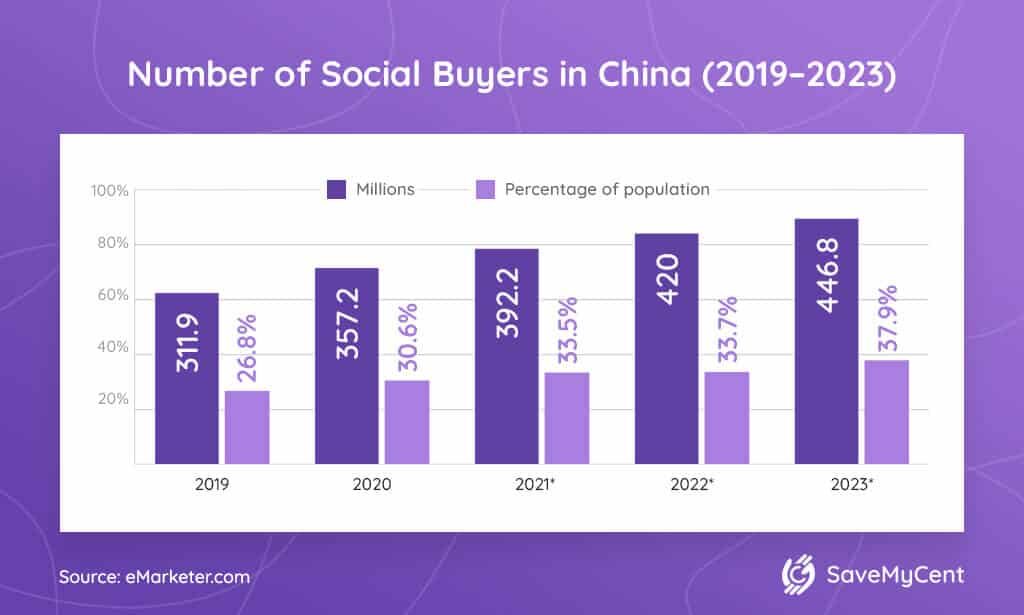
5. In 2021, there will be 3.78 billion social media users.
(Statista)
That’s a hell of a lot potential customers! This number also represents a 42% increase in social media users in the last decade. Chances are that this figure will only grow in the years to come.
6. 35% of consumers abandon carts because the shop asks them to create an account, while 27% think the checkout process takes too long or is too complicated.
(ReadyCloud)
Online shops that add additional costs suffer. Most buyers are put off by the extra money they need to spend at checkout. Baymard Institute research says that 61% of shoppers abandon their carts due to these unnecessary expenses.
7. 71% of online shoppers will recommend the brand they bought on social media.
(ReadyCloud)
According to a recent social commerce report, this mouth-to-mouth promoting practice can help increase brand awareness. So, many brands and businesses strategize how to use social media to improve their image, generate higher brand engagement and provide exceptional customer service. These are, in essence, the goals of social commerce.
8. Apparel made up 21.69% of the total social commerce revenue in 2020.
(Grand View Research, Facebook)
Clothing is the largest segment of social commerce, along with beauty. Beauty and fashion as a part of social commerce are expected to grow further in the next few years. This is not surprising, as 55% of US fashion shoppers who follow fashion influencers state they’ve bought a fashion product after seeing an influencer promote it.
9. Social media recommendations influence 23% of online consumers.
(Disruptive Advertising)
Many buyers believe in referrals and recommendations of influential social media moguls. Plenty of brands use Instagram influencers to promote their products. This marketing practice is very popular and effective nowadays.
10. 84% of US online buyers take a look at a social media website before purchasing.
(Disruptive Advertising)
Close to 90% of online consumers reach for social media reviews to guide them through making the right shopping decision. Customers using social commerce benefit from gaining insight into what is the best product they can find at an affordable price.
11. Customers referred from Facebook order $55 worth of goods on average.
(Disruptive Advertising)
Brands and businesses that market and promote their products through social commerce know that buyers won’t make impulse shopping decisions that will cost them a lot of money. So, they usually sell items not more expensive than a hundred dollars on social media, social media ecommerce statistics say.
12. Social media posts with visual content have 104% more comments, 53% more likes, and 84% higher click-through rates.
(Disruptive Advertising)
Social commerce uses this visual social marketing strategy to grow more conversion rates, attract more consumers, and generate more traffic. Researchers proved that visual content generates emotional responses in viewers and leaves memorable impressions in their minds.
Social marketers make the best of this fact by creating and promoting pictures of their products on social media.
13. According to social commerce statistics of 2020, Social media posts with no more than 80 characters engage more users.
(Disruptive Advertising)
Posts longer than 80 characters drive 34% of users’ engagement, while shorter ones engage 32% more users.
The golden rule of social media commerce posts.
They should be concise and stick to the point.
The thing is:
Most users just skim through their feed. So, marketers don’t have a lot of time to catch the eye of their potential clients. They have to make it memorable, short, enticing, and readable.
14. The average value of orders from Twitter is $46.29.
(Disruptive Advertising)
A lot of online consumers trust Twitter when it comes to making a purchase decision. So, the Twitter ads’ click-through rate is between 1% and 3%. Brands promote and sell their products on the platform to attract consumers who are very straightforward in expressing their opinions and preferences.
15. 75% of Instagrammers visited a website or took a similar user action after encountering an Instagram ad, social commerce trends show.
(Disruptive Advertising)
Since they appeared in 2013, Instagram stories, collection, carousel, and photo ads have been helping brands and businesses advertise their products and reach a large number of consumers.
Check this out:
35% of adult Americans use Instagram, so more than 500,000 brands are using this platform for both promotion and sales. Most Instagram advertisements offer different call-to-action options and customer poles to boost sales and customer engagement.
16. The average worth of products for consumers referred from Insta is $65.
(Disruptive Advertising)
This statistic shows that the average value of items purchased from Instagram referrals is 19% larger in comparison to Twitter’s order percentage. So, naturally, the majority of brands opt for Instagram, social ecommerce statistics say.
17. The average order worth for consumers referred from YouTube is $37.63.
(Disruptive Advertising)
YouTube is a powerful social commerce tool, with over a billion users. Nowadays, YouTube consumers access the platform predominantly on their mobile devices. Researchers say that video content published on YouTube converts at 1.16%. Also, the average order value on Pinterest is $58.95, $66.75 on Polyvore, and $52.96 on Reddit.
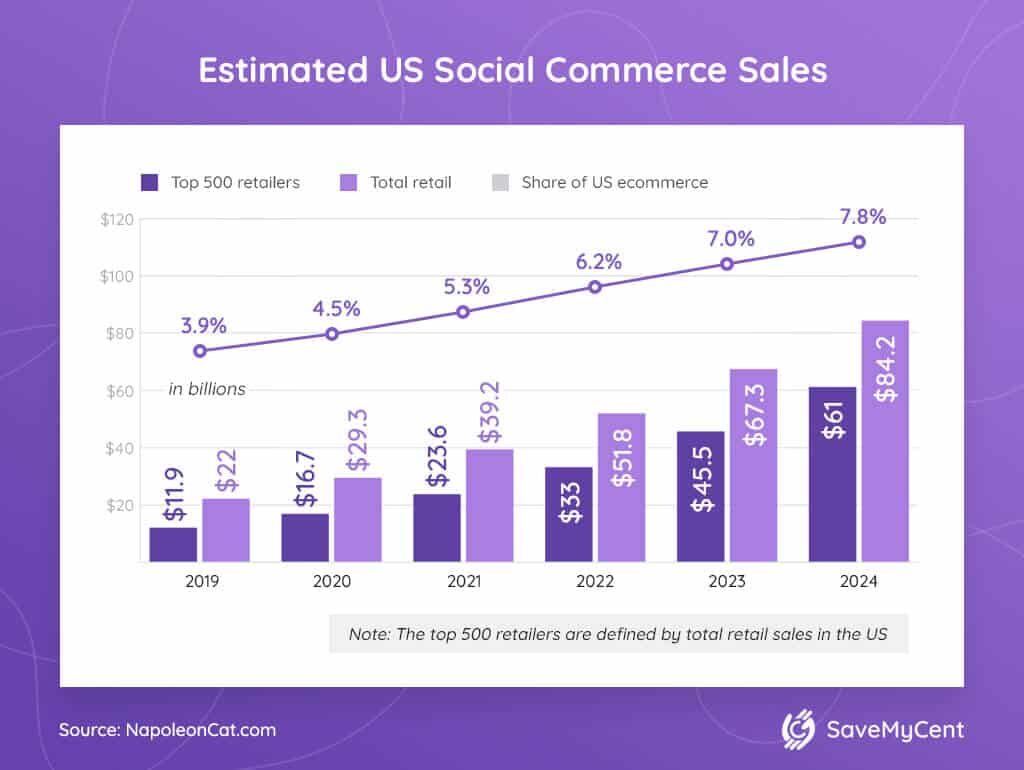
Social Media User Demographics and Social Commerce Stats
18. Most TikTok users in the US are aged between 10 and 29.
(Statista)
More than 50% of TikTok users are active on the app, producing and consuming content every day. This has prompted Walmart, whose customer base consists mostly of Baby Boomers, to offer a deal to buy 7.5% of TikTok’s stake. It’s left to see how social commerce will evolve in the next couple of years.
19. 87% of users turn to social media for help in making a shopping decision.
(Smart Insights)
This high percentage of consumers looking for shopping insights from social media networks brings large profits to social commerce.
As it turns out:
30% of the respondents would make their purchases directly through social media. That’s why 40% of brands generate their sales and boost consumer engagement through social commerce.
In 2020, all of the top social commerce companies, including YouTube, Coca-Cola, Samsung, and McDonald’s, used Instagram and Facebook to promote their products and increase sales.
20. In 2020, most US consumers showed reluctance to make purchases through social media platforms.
(eMarketer)
At the time, only 6% of respondents said they bought goods directly through social networks on a regular basis. Ecommerce was more popular with Americans than social commerce predominantly because of security concerns.
21. According to the latest data, 51% of internet users aged 16-24 used social media to browse and discover brands globally.
(Statista)
Out of these respondents, 28% said that they found interesting brands by skimming the news feed and ads on social networks, social commerce statistics in 2019 confirm.
22. The latest figures show that nearly eight in ten US shoppers use Amazon for online shopping guidance.
(Statista)
And when it comes to specific products, almost 49% of interviewees started their product search on this popular e-retail platform.
23. 18.3% of US adults made a purchase through Facebook in 2020.
(eMarketer)
At the same time, 11% of adults purchased something via Instagram.
However, 70.4% of those surveyed didn’t purchase anything through social media during that period. Although Instagram added the option to shop directly, and Facebook is working on expanding social commerce with Facebook shops, the idea still hasn’t gained critical popularity.
24. As of January 2019, 42.9% of worldwide respondents aged 55 to 64 had never made an online purchase.
(Statista)
This global statistic proves that the elderly are still reluctant to trust social media ads or sales to make their purchases.
In contrast:
29.3% of people aged 25 to 34 were more likely to shop on social media platforms.
25. More than 50% of Gen-Z and Millennials’ fashion purchases are inspired by social media, social commerce use statistics reveal.
(NapoleonCat)
Younger Americans spend a lot of time browsing social media. A large portion of the Gen Zero and Millennial population follow Facebook or Instagram pages that advertise apparel and fashion. So, it should come as no surprise that they get their fashion into through social media channels.
26. As of February 2019, 47% of Americans used Pinterest as a primary source for finding and shopping for products, social commerce statistics reveal.
(eMarketer)
Additionally, 15% of social media users took to Facebook, and 11% reached for Instagram to find items.
Social Commerce Revenue Stats
27. By 2021, ecommerce sales are projected to hit $4.5 trillion, social commerce growth statistics confirm.
(ReadyCloud)
This figure shows a massive growth from 2014 when sales reached $1.3 trillion. So, if you’re an e-tailer or plan on becoming one, don’t lose time.
Company Social Commerce Strategies
28. According to social commerce stats, in 2021, 91.9% of U.S. marketers will use social media for marketing purposes.
(Statista)
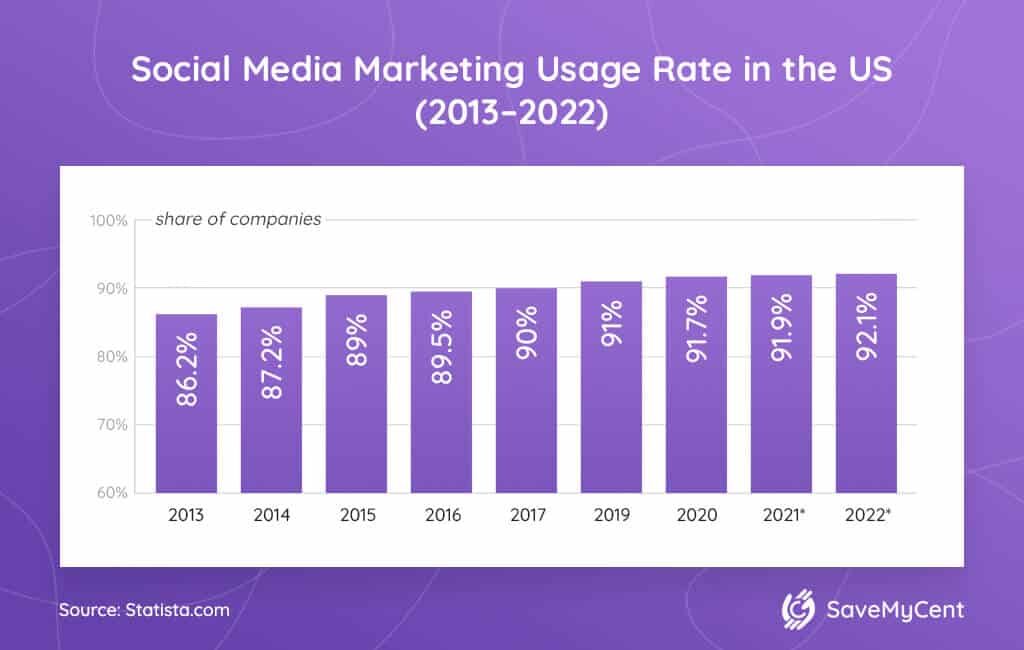
The numbers are clear. Social media is essential in creating demand, as well as reaching potential customers. While this was also true eight years ago, when 86.2% of marketers saw the potential, today, commerce cannot be imagined without social media.
29. 86% of the top 25 companies use the Facebook Like Button.
(Invesp)
Social networks e commerce statistics tell us the most popular social commerce features that can be used on the most popular ecommerce web pages by 25 best businesses are:
- Social Login – 82%
- Twitter Tweet Button – 86%
- Ratings & Reviews – 82%
- Product recommendations – 82%
30. 94% of social orders for the Sports and Recreation industry come from Facebook.
(Invesp)
According to the same research, here are some of the percentages of orders from other industries originating from Facebook:
- Photography – 98%
- Jewelry & Watches – 92%
- Clothing & Apparel – 87%
- Web Design – 81%
- Pet Supplies – 94%
31. Nomorerack.com gets 35% of traffic from social media.
(Invesp)
Here is the list of other US e-tailers and their share of social network traffic:
- Zappos – 10.16%
- Fab.com – 25%
- Nordstrom – 8.5%
- ShoeDazzle.com – 10.5%
32. 90% of e-tailers think digital coupons improve their offer personalization.
(SILO)
Digital coupons are an essential part of social commerce tactics, social commerce stats confirm. If a brand makes a relevant and well-targeted campaign, it can help them retain existing customers and win their loyalty.
Also, digital coupons are a great way to acquire new consumers. With good incentive, brands can attract customers who typically would not buy their product.
33. 93% of global marketers used Facebook in January 2021.
(eMarketer, Statista)
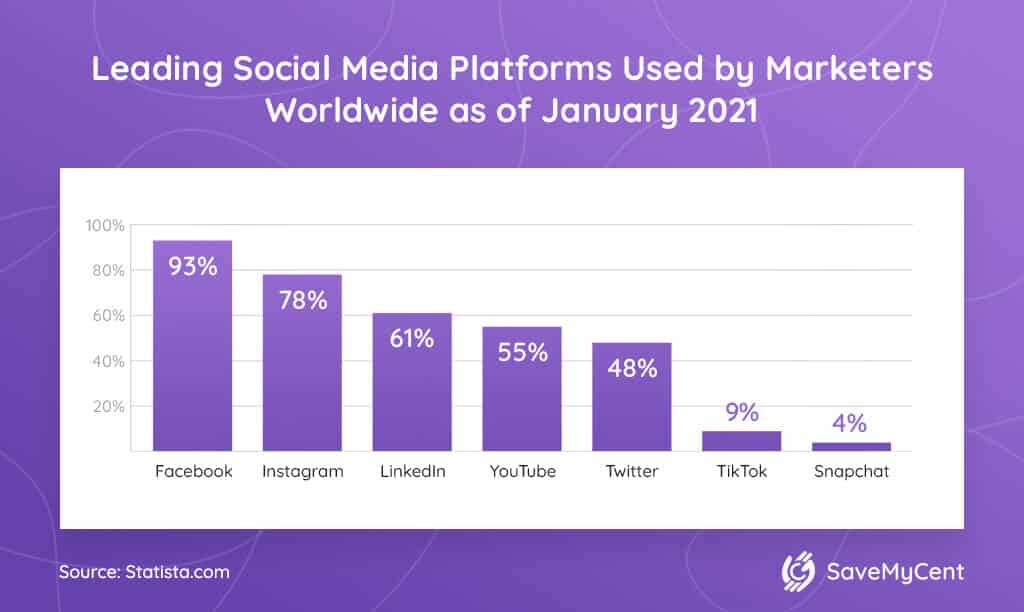
The same research discovered that social commerce companies upped their usage of Instagram as a primary tool for social commerce at the beginning of 2021 to 78%. While Facebook remains the most popular social commerce platform, the situation changes when researchers survey younger audiences.
Is your product aimed at younger audiences?
Go to Instagram. According to eMarketer, 73% of teens named Instagram as their platform of choice for promotions and following brands.
34. 4 million businesses on Instagram used Stories ads in 2020.
Establishing a more personal, open, and less polished approach with consumers is an essential tool in marketing today. Small businesses make use of this option especially well, as they do have a more personal approach to customers.
Final Words
All things considered, the use of social media platforms to purchase, sell and promote brands and their products is growing by the day, social commerce statistics confirm.
Key takeaway:
Social media and ecommerce are becoming one to make online shopping more efficient, quick, and simple.
So, marketers should think about the best social commerce strategy and tools to optimize sales and engage more potential clients as soon as possible.
Sources:

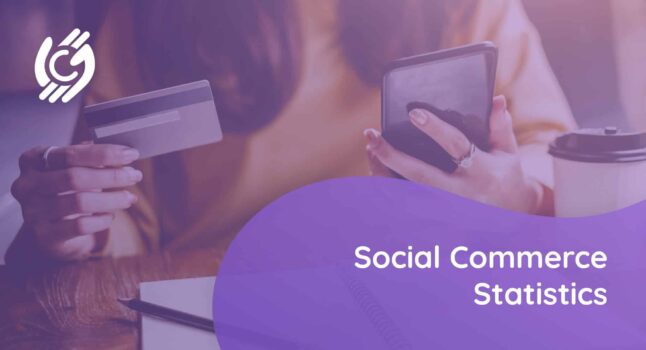





![How to Get Free Clothes From Shein? [2024 Guide]](https://savemycent.com/wp-content/uploads/2023/09/How-to-Get-Free-Clothes-From-Shein-336x220.png)
